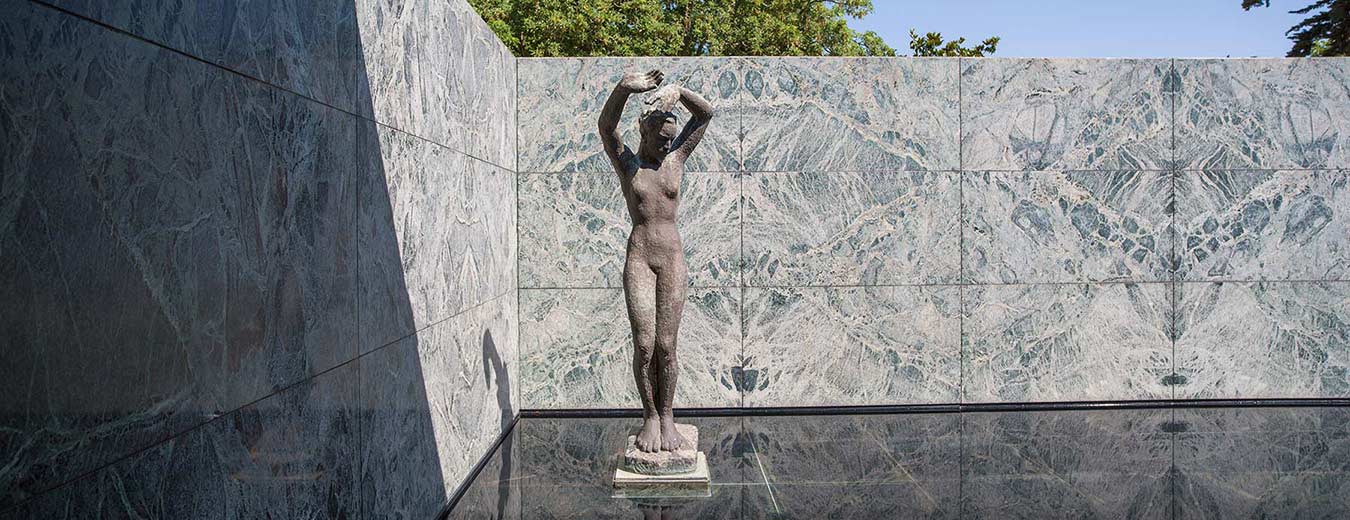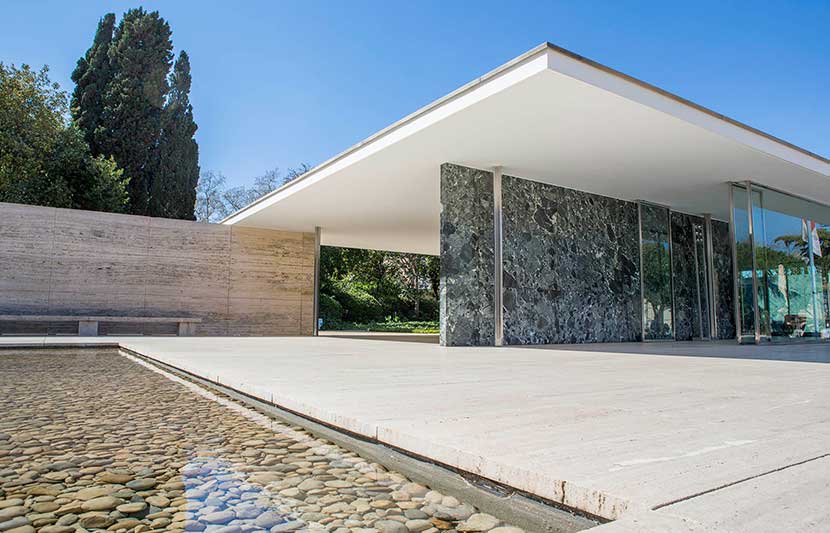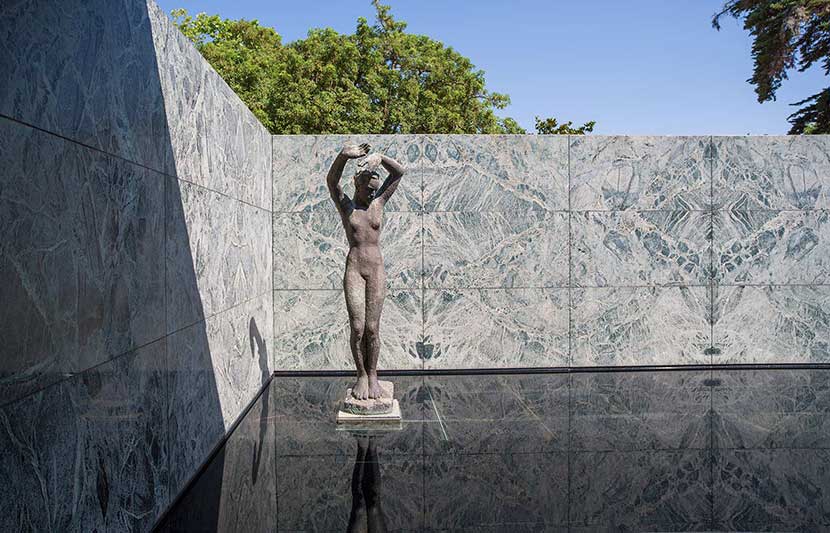The Mies van der Rohe Pavilion in Barcelona
The Barcelona Pavilion and the Barcelona chair
The Pavilion is one of Ludwig Mies van der Rohe’s seminal Works and a key point of reference in XX-century architecture. The famous German Pavilion was built for the 1929 Barcelona International Exhibition and disassembled the following year.
Half a century later, and in view of the importance of the Pavilion in terms of contemporary architectural history, the Barcelona City Council, with architect Oriol Bohigas at the head of its Urban Planning Department, decided to faithfully reconstruct the building. The project was carried out after extensive research by Ignasi de Solà-Morales, Cristian Cirici and Fernando Ramos between 1983 and 1986 on the Pavilion’s original Montjuïc site.
The famous Barcelona Pavilion designed by Mies van der Rohe for the 1929 World Exhibition
Its innovative architectural structure marked a radical change in the layout of space and greatly influenced the development of modern architecture. Furthermore, the Pavilion exhibits the Barcelona Chair, also designed by Mies, along with a bronze reproduction of Georg Kolbe's sculpture Morning.
The materials
Glass, steel and four different kinds of marble (Roman travertine, green Alpine marble, ancient green marble from Greece and golden onyx from the Atlas Mountains) were used for the reconstruction, all of the same characteristics and provenance as the ones originally employed by Mies in 1929.
Mies van der Rohe's originality in the use of materials lay not so much in novelty as in the ideal of modernity they expressed through the rigour of their geometry, the precision of the pieces and the clarity of their assembly.
The Barcelona chair
Mies van der Rohe designed a chair, especially for the Pavilion, consisting of a leatherupholstered metallic profile that over the years has become an icon of modern design. To such an extent, in fact, that the Barcelona chair is still manufactured and marketed today.
Georg Kolbe's sculpture
The sculpture is a bronze reproduction of the piece entitled Dawn by Georg Kolbe, a contemporary of Mies van der Rohe's. Masterfully placed at one end of the small pond, the sculpture is reflected not only in the water but also in the marble and glass, thereby creating the sensation that it is multiplied in space, while its curves contrast with the geometrical purity of the building.
The famous Barcelona Pavilion designed by Mies van der Rohe for the 1929 World Exhibition
Fundació Mies van der Rohe
The Fundació Mies van der Rohe was set up in 1983 with the aim of working towards the reconstruction of the Pavilion. Since the completion of the project, the Foundation, member of the International Confederation of Architectural Museums (ICAM), has been entrusted with the task of preserving and managing the Pavilion.
The Foundation also focuses on fostering debate on contemporary architecture and urbanism, building a documentary archive on Ludwig Mies van der Rohe and on modern and contemporary architecture, and organising correlated awards, courses, lectures, exhibitions, publications and studies.
Ludwig Mies van der Rohe (1886 – 1969)
Ludwig Mies van der Rohe was born in Aachen, Germany in 1886. As a result of time spent working under the influence of Peter Behrens, Mies developed a design approach based on advanced structural techniques and Prussian Classicism. Famous for the phrase ‚less is more,‛ he fostered a style of architecture based on material honesty and structural integrity. Over the last twenty years of his life, Mies achieved his vision of a monumental ‘skin and bone’ architecture, his later works embodying the idea of universal, simplified architecture.
His major works include amongst others: Werkbund Exposition and Apartments: Weissenhofsiedlung, Stuttgart, Germany, 1927; H. Langer House, Krefeld, Germany, 1928; German Pavilion, Barcelona, Spain, built 1928-1929, demolished 1930; Tugendhat House, Brno, Czech Republic, 1930; Farnsworth House, Plano, Illinois, 1946-1950; Lake Shore Drive Apartments, Chicago, Illinois, 1948-1951; Crown Hall (IIT), Chicago, Illinois, 1950-1956; Seagram Building, New York, 1954-1958; New National Gallery, Berlin, Germany, 1962-1968.
Pavelló Mies van der Rohe is a symbolic work of the Modern Movement. In 1929 the architect Ludwig Mies van der Rohe designed the German national pavilion for the Barcelona International Exhibition. For this reason it is also called the German Pavilion. In 1986 the Catalan authorities decided to rebuilt the Pavilion on its original site using the original drawings by Mies van der Rohe (Av. Francesc Ferrer i Guàrdia, 7 Parc de Montjuïc).
This happened thanks to the importance and reputation of the Pavilion as well as the fact that Ludwig Mies van der Rohe had become a key point of reference. In 1980, Oriol Bohigas, as head of the Urban Planning Department at the Barcelona City Council, set the project in motion, designated architects Ignasi de Solà-Morales, Cristian Cirici and Fernando Ramons to research, design and supervise the reconstruction of the Pavilion. The building consists of basic and elegant materials, like marble, glass and steel. The Pavilion is one of Ludwig Mies van der Rohe’s seminal Works and a key point of reference in the XX-century architecture. Its innovative architectural structure marked a radical change in the layout of space and greatly influenced the development of modern architecture. It is essential to go inside of the building in order to enjoy the singular space. it also exhibits the Barcelona Chair, designed by Mies, along with a bronze reproduction of Georg Kolbe's sculpture Morning.
This famous building done by a German architect is opened daily from 10 to 20 hours. The Fundació Mies van der Rohe is in charge of conserving and disseminating knowledge about the Pavilion since 1983. This building is a result of the influence of Peter Behrens and made an impact on the world of modern architecture.
Visiting hours for the Barcelona Pavilion
Every day from 10.00 to 20.00h.
Entrances
- General public: 4.75 €
- Students: 2.60 €
- Under 16: free
- Annual subscription: 8 €
Entrance fee for groups
More than 20 people with reservation required: 4 €. Guided tours for groups of up to 25 people with reservation required: 60 €.


